The following accounts of field operations are derived from a team scrapbook put together by Nickie Leyen, are NOT official reports, and may have errors and omissions. For missing months, we have no information.
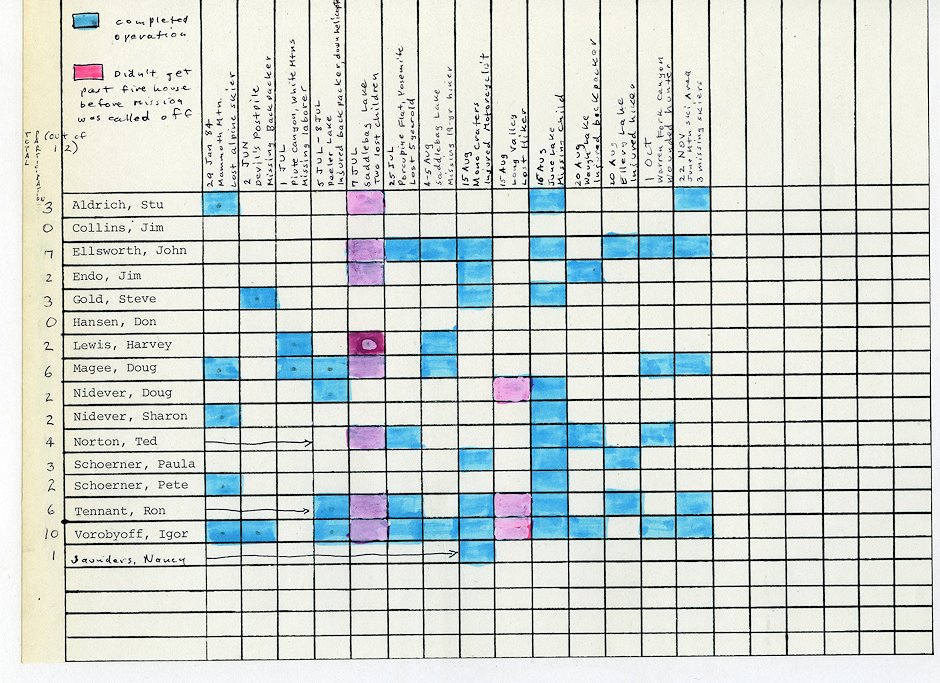
1984 June Lake Search and Rescue Team
(Stu Aldrich, Jim Collins, Jim Endo, John Ellsworth, Steve Gold, Dan Hansen, Harvey Lewis, Doug Magee, Doug Nidever, Sharon Nidever, Ted Norton, Pete Schoerner, Paula Schoerner, Nancy Saunders, Ron Tennant, Igor Vorobyoff)
January
From Mono Herald newspaper report:
The Lee Vining Chapter of Delta Epsilon Gamma Sorority had two meetings in January. On January 9, members met at the home of Dorothy DesBaillets for a program on Early American furniture and its influence on American society. On January 16 Freda Bolin was the hostess and presented a program on Friendship and its meaning.
Delta Epsilon Gamma has generously donated $300 to the June Lake Search and Rescue Team. This is the second year that the sorority has donated to this worthwhile group. They feel the rescue team needs more community support.
January 28, 1984 Mammoth Ice Rescue Test. The June Lake Search and Rescue Team assisted in a rescue exercise conducted by the Mountain Rescue Association. The exercise was part of the certification process for the Mammoth Lakes Search and rescue Team, which is trying to become a member of the MRA. June Lake participants were: Pete Schoerner (the "victim"), Igor Vorobyoff (the "RP"), John Ellsworth, Jim Collins, Sharon & Doug Nidever, Harvey Lewis
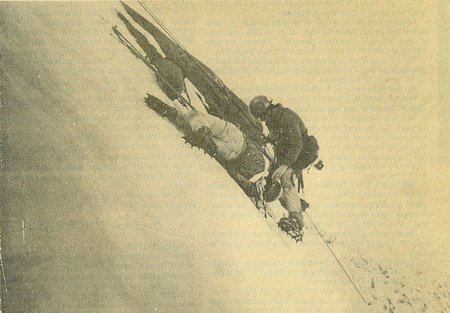
An "injured" climber is checked by a member of the Mammoth Lakes Search and Rescue Team on a steep frozen slope above Silver Lake
Doug Nidever Photo
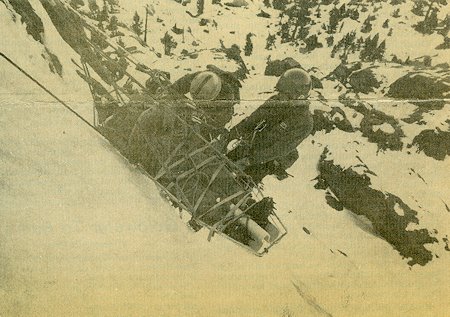
After being given first aid, the "injured" climber is lowered down the slope in a liter by rescuers - Doug Nidever Photo
From Sierra Daily News newspaper report by Martin Strelneck:
Mammoth Rescuers Need Little More Practice
The scene is a frozen waterfall high above the Rush Creek Power Plant in the June Lake Loop where a climber has fallen several hundred feet and is now hung upside down, seriously injured. The frozen terrain will require rescue personnel with technical skills in ice climbing to remove him safely.
This was the simulated problem facing the Mammoth Lakes Search and Rescue Team on Saturday as it sought to gain certification from the Mountain Rescue Association in winter rescue techniques. The judges were members from 10 statewide search and rescue teams and the exercise was hosted by June Lake's Search and Rescue squad. Mammoth's team had high marks in most areas, but will have to try again, the judges decided.
"What we are seeing here is a dry run of what happens many times every year," said Tim Fives, vice president and training coordinator for the California Region of the Mountain Rescue Association. He explained that the members of the Mammoth group would be judged on their skills, techniques and methods used in removing the "injured" climber from the ice field, and, upon completion the entire group would meet and critique the operation pointing out both strong and weak points.
Fives, who is a member of the Sylmar Mountain Rescue Team, said that for a team to become a member of the Mountain Rescue Association it is necessary that it be certified in three areas of rescue work - snow, ice, rock and search. The Mountain Rescue Association is a nationwide group that, in the words of June Lake Search and Rescue Team leader John Ellsworth, provides the "back up and skill of an organization that has been in the business a long time."
The June Lake team successfully gained certification and membership in the MRA several years ago and has been working with Mammoth on various training exercises.
Despite Mammoth not "passing" the test, Fives had high praise for the group.
"You can't think of it in terms of pass or fail. It (the first test) is considered a necessary hurdle in the learning experience. You take what you did wrong and do better when you take the test again," Fives said, adding that it is "unusual" to pass the test on the first try.
Fives said Mammoth was "well equipped and had strong technical skills with a lot of potential. The Mammoth team is really top flight and technically very well skilled in ice climbing, which is unusual for a team testing for the first time. There's no way to fault them for that."
Where Mammoth went wrong was in "organization time," Fives said. "With such serious injuries they would have to move faster to reach a victim.
Also taking part in the operation as observers were members of the San Diego Mountain Rescue Team, Altadena Mountain Rescue Team, Bay Area Mountain Rescue Team, China Lake Mountain Rescue Team, June Lake Search and Rescue Team, Inyo County Search and Rescue Team, Sierra Madre Search and Rescue Team, Sylmar Mountain Rescue Team, Riverside Mountain Rescue Team and Montrose Mountain Rescue Team.
January 29, 1984 Mammoth Mountain - Lost alpine skier. Called out at 0600, on the road at 0730. Arrived Mammoth Mountain ski patrol room 0815, at which time a patrolman radioed in that he had found the lost skier in good condition and would escort him back. Responders were: Aldrich, Magee, Sharon Nidever, Pete Schoerner, Vorobyoff
From Sierra Daily News newspaper report:
Skier Found Members of the Mammoth Mountain Ski Patrol located a 30-year-old San Diego man Sunday morning after he became lost on Mammoth Mountain on Saturday. Robert Lavigne was found in good condition by patrolmen on the back side of the mountain. The search effort involved the Ski Patrol and members of the Mammoth Lakes Search and Rescue Team.
According to Gary Reitman, head of the Mammoth Mountain Ski Patrol, Lavigne skied past two signs designating the closed area.
June
June 2, 1984 Devil's Postpile - Missing backpacker - Gary Power, from England, lost the sleeping bag from his pack while hiking west over Mammoth Pass to Rainbow Falls. He left his pack with his two companions and attempted to retrace his steps over the patchy snow to retrieve his sleeping bag. Becoming disoriented, he wandered down to Red's Meadow, and finding no one there, he headed east up to Mammoth Mountain. He followed ski lifts down to Highway 203, where he hitched a ride to Mammoth Lakes and reported to the Sheriff's Department. By this time the Mammoth SAR Team was at the point last seen together with the RP, and Gold and Vorobyoff were crossing Mammoth Pass to join the effort. Responders were: Gold, Vorobyoff, Mammoth SAR Team
From The Review newspaper report:
Power Found Safe and Sound A four-hour operation by the Mammoth Search and Rescue Team in the Red's Meadow area was called off Saturday, June 2, when deputies found the object of their hunt in the middle of Mammoth Lakes. Gary Power, 21, had been reported missing by friends. Power walked back into town and was in good condition, the Mono County Sheriff's Department reported.
July
July 1, 1984 Piute Canyon, White Mountains - Missing laborer - Bill Simmons, age 70, was working with two other persons whom he was to pick up at another location. He never showed up. The other workers walked out and reported him missing. He was found by Officer Wallizen of the CHP at about 1800 hrs suffering from dehydration. Rescue personnel arrived about 10 minutes after he was found and transported water and insulin (Simmons is a diabetic) to the victim's location. Responders were: Lewis, Magee, Mammoth SAR Team
July 5-8, 1984 Peeler Lake - Injured backpacker (killed in helicopter crash) - Tom Fenelon, age 27, fell 15 feet on a granite slab while hiking and suffered a lacerated knee, a possible sprained hand and a bump on his head. A CHP Ranger helicopter went in from Bridgeport airport at 1300 hrs to pick him up on the southeast shore of Peeler Lake with the pilot and observer aboard.
Concerned over the excessive absence of the helicopter, Nidever and Vorobyoff drove to the Twin Lakes trailhead in anticipation of a walk-in, leaving Tennant with the RP at the airport. Vorobyoff began walking in at 1545.
At 1645 he met two hikers near Barney Lake, on their way down from Peeler Lake to report that the helicopter crashed into the lake on take-off, dropping to a depth of 60 feet. The pilot suffered back injuries, the observer had only minor injuries, and Tom Fenelon was killed.
Vorobyoff immediately radioed this information to the rescue van. A second CHP Ranger arrived within minutes to pick up the survivors and fly them to Bridgeport Hospital.
Next day, 6 July, the Sheriff's divers recovered Tom's body, which had floated to the surface overnight.
On 7 July Doug Magee and Vorobyoff were helicoptered to Peeler Lake to assist the Sheriff's dive team to stabilize the helicopter and salvage CHP and personal possessions.
The helicopter was removed on 8 July by professional divers and the Sheriff's dive team. Mammoth SAR Team participated as back-up on 5 July. Responders were: Doug Nidever, Ron Tennant, Vorobyoff, Doug Magee, Mammoth SAR Tream, Sheriff's Dive Team
From Sierra Daily News newspaper report:
Copter Crash Kills Rescued Hiker An injured hiker was killed Thursday when the California Highway Patrol helicopter which had flown into the Sierra to rescue him lost power and plunged into the freezing water of Peeler Lake on the border of Mono and Tuolumne Counties, officials said.
The dead man was from the San Francisco bay area, authorities said, but his identity was being withheld Thursday night. Neither his body nor the helicopter had been recovered, however, because the craft sank immediately upon hitting the lake, authorities said.
Two Highway Patrolmen on the helicopter escaped with their lives, however. They were identified as pilot Will Benda and observer Randy Byerly, both of Sacramento. Both were suffering from extreme hypothermia, and Benda had leg and back injuries as well.
The hiker had apparently fallen and suffered leg and head injuries, according to the Mono County Sheriff's Department, and the CHP helicopter from Sacramento responded to the lake, at the 9,600-foot level on the Mono-Tuolumne county line, five miles from the trailhead above Twin Lakes.
The CHP rescuers found the injured hiker and placed him in the helicopter, but as they were leaving the scene, according to CHP Public Affairs officer Kent Milton in Sacramento, "they lost power for some reason. We don't know why."
Milton said the plane "rotated into the lake, crashed, and sank immediately. The two rescuers were able to free themselves and get to shore, but the injured man could not. We presume he drowned." Milton said.
"It was extremely cold," he added. "Getting out of the helicopter under those conditions was a real chore," he added.
When Mono County and CHP officials lost contact with the Sacramento helicopter, a second was sent in, this time from Fresno. By late afternoon, the second group of rescuers had caught up with the ill-fated first crew, and flew them to Mono General Hospital in Bridgeport.
We just don't know why this happened," Milton said. "We can't tell anything from the helicopter at the bottom of the lake, so we probably won't know anything for several more days," he added.
Mono County and CHP officials will begin an operation this morning to recover the helicopter and the dead man's body.
Before the terrible ending, the rescue had been "just a typical mission," Milton said. "There are so many questions we just can't answer now," he said.
The conditions at the time of the accident included high winds, extremely poor visibility, and thundershowers, he said.
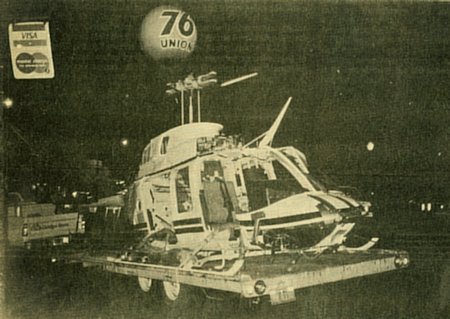
The wreckage of a California Highway Patrol Bell Jet Helicopter that crashed in Peeler Lake in Mono County on Thursday during a rescue mission for an injured hiker is trailered through Bishop Sunday night. The helicopter was removed from the 60 foot level of the lake on Sunday and is being taken to Van Nuys for further examination. The hiker was killed in the crash and the two CHP officers on board were injured - Martin Strelneck Photo
From Sierra Daily News newspaper report by Martin Strelneck:
A California Highway Patrol Helicopter was recovered Sunday from Peeler Lake, after crashing Thursday while on a rescue mission. The body of a man killed in the crash was also recovered, after it floated to the surface Saturday.
According to CHP Mono County Commander, Lt. Ted Engstrom, the craft which was located Saturday by Mono County Sheriff Dive Team personnel, was removed from the lake and flown to Bryant Field in Bridgeport. Sunday's recovery was made successful due to the coordinated efforts of the Mono Sheriff Dive Team, a team of commercial divers from the bay area and a large Chinook Helicopter flown by the Air National Guard.
The craft had crashed on Thursday, after picking up Thomas W. Fenlon, 27, of Oakland who had suffered injuries in a fall in the rugged backcountry. The craft apparently lost power while over the lake and fell into the water, according to the CHP.
Fenelon died when the craft sank, but the pilot, Will Benda and observer Randy Byerly were able to make shore with Benda suffering from serious back and leg injuries.
Both men were flown from the location to Mono General Hospital by another Highway Patrol Helicopter, where Benda was treaded and then flown to Saint Mary's Hospital in Reno. On Sunday afternoon a hospital spokesman reported that he was in good condition. Byerly was not injured in the accident.
Engstrom said the aircraft, a specially equipped Bell Jet Ranger recently purchased by the Highway Patrol, appeared to be severely damaged and was being trucked to the Van Nuys area for examination and further investigation. Engstrom said that fully equipped, the craft cost in excess of $900,000.
Engstrom didn't think the crash would hinder future rescue efforts.
"I am sure it will be discussed, but considering how many lives have been saved in the past and the number of injuries that were not aggravated, I can't see canceling any future plans," said Engstrom.
July 7, 1984 Saddlebag Lake - Two lost children - Two children ages 4 and 8 were reported missing from the Saddlebag campground after about 2 hours. They were found before the rescue van left the fire house. Responders were: Ellsworth, Magee, Endo, Tennant, Norton, Aldrich, Vorobyoff
July 25, 1984 Porcupine Flat, Yosemite - Lost 5 year old - MRA requested assistance in an NPS search for Annie, 5 years old, who strayed from camp at 1730 on 24 July. In the morning the JLMRT searched a bee-line due north of the camp for 2 miles, skirted the east edge of the flat and searched the hills east of the flat. In the afternoon the team was helicoptered into the Lehomite Creek drainage, where it searched south from Indian Rock to the rim of Yosemite Valley. Annie walked out on her own to the highway by Coyote Rocks (2 miles east of PLS) in good condition at about 2000 hrs. Responders were: Ellsworth, Vorobyoff, Norton, Tennant
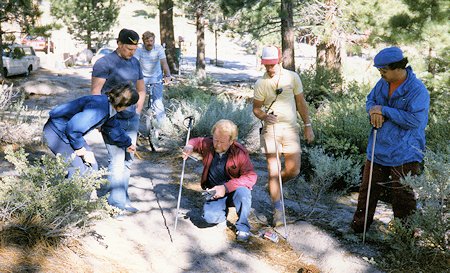
Searchers evaluating tracks possibly left by Annie Coleville
From Mono Herald newspaper report by Rosanne Hixley:
Extensive Search Underway Rangers, the search and rescue team, dogs and a helicopter were searching Wednesday for 5-year-old Annie Colville, of Fountain valley, after she disappeared from her parents' campsite at Porcupine Flat in Yosemite National Park Tuesday evening.
The young girl was last seen by her parents about 5:30 p.m. as they were setting up camp. The park service initiated the search at 6:30 p.m. after being notified that she was missing. The search continued until midnight, then resumed at 3 a.m. At 9 a.m. Wednesday, 85 people, seven search dog teams, four blood hounds, and the park service helicopter were combing 200 to 400 acres in search of the young girl.
Overnight temperatures at the campground, located at 8,100 feet, were in the mid-30s.
From Mono Herald newspaper report by Rosanne Hixley:
Fountain Valley Girl Found By Motorist After 26 Hours A 26-hour search in Yosemite National Park ended happily for the family of Annie Colville, 5, of Fountain valley, Calif. The young girl was found by a motorist about 8:30 p.m. Wednesday walking along the road. She was located three miles east of Porcupine Flat campground, where she was last seen by her parents the evening before.
Despite spending the night at 8,100 feet in near freezing temperatures, she was in perfect health, according to park service spokesperson, Lisa Dapprich. Dapprich added that the five-year-old spent her ordeal walking and napping, and she had picked wildflowers for her family.
The search for the girl had begun Tuesday evening about 6:30 p.m. when her parents reported her missing. A total of 130 ground personnel, seven search dogs, four blood hounds and a helicopter were used in the search.
Thank you letter from parents:
We are writing this note to express our deepest thanks and gratitude to every one of you who helped in the search of our 5-yr old daughter Ann, in Yosemite last week.
We wish it were possible to personally thank each one of you, but since it isn't we hope you'll all remember how special you are to us and that we shall NEVER forget that such wonderful people came to help us in our time of desperate need.
We were so comforted knowing there were experienced searchers looking for Ann at a time when we, as parents, felt so totally helpless.
If there is ever any way we can help you or any other family as a result of our experience we would be happy to be of help. Please let us know.
Thank you again from the bottom of our hearts.
Micki & Doug Colville, Fountain Valley, CA.
August
August 4-5, 1984 Saddlebag Lake - Missing 19 year old hiker - Jeff Styles, 19 years old, was separated from his hiking companions enroute to North Peak. He was wearing a T-shirt and jeans and carrying a day-pack containing a Walkman set and crampons.
June Lake SAR was notified via the Forest Service at 2100 hrs. The van left June Lake one hour later (including a stand-by period), reaching the wilderness ranger's (Howard Moser) cabin at 2330.
At 0000 hrs Vorobyoff left for North Peak with Moser, getting to the peak uneventfully at 0315 hrs. The victim had not signed the Sierra Club log.
In the morning Vorobyoff and Moser searched the peak and its east slopes while Lewis and the Mammoth SAR team searched the rest of the Conness Lakes basin.
A CHP helicopter began searching the peak area at 1100 hrs. A Yosemite helicopter landed and checked campsites at Lake Roosevelt and Upper McCabe Lake (the west side of the peak) in the early afternoon.
At 1300 hrs the ground teams were redeployed on the northeast slope of North Peak and in the 20 Lakes Basin.
At 1600 hrs the victim was found on a dirt road in Lundy Canyon by a passing vehicle. He was in satisfactory condition. All teams, including one landed at Upper McCabe Lake by helicopter, returned to base by 1730 hrs.
The only error brought up in the search critique was that confinement was inadequate in Lundy Canyon. A search team should have started up the canyon in the morning. Responders were: Ellsworth, Lewis, Magee, Vorobyoff, Mammoth SAR Team
From Mono Herald newspaper report by Rosanne Higley:
Motorist Finds Hiker Near Lundy Canyon A search that began about 10 p.m. Saturday at Saddlebag Lake was called off Sunday afternoon when the lost hiker, Jeffrey Styles, walked out of Lundy Canyon.
Styles, 19, of Danville, Calif., was last seen by his group of 24 hiking toward North Peak, a rugged granitic peak near Saddlebag Lake, about 3 p.m. Saturday. When he did not return to camp, the group reported him missing, instigating a search involving the June Lake and Mammoth Lakes Search and Rescue teams, a Forest Service Wilderness Ranger, a National Park service helicopter and the California Highway Patrol helicopter.
The search was made more difficult by the presence of many hikers in the area. Search coordinator, Ken McClintock, said that it is harder to search where there are many people and tracks in a concentrated area.
Mavis Grover, owner of Saddlebag Lake Resort, estimated there were over 125 people in the 20 Lakes Basin, the area below North Peak.
Styles was found walking along the road near Lundy Lake by a motorist. The motorist notified authorities when Styles identified himself as being lost. Word was received by the searchers at Saddlebag and the search was cancelled at 4:30 p.m.
After meeting with Styles, McClintock said the young man "knew he was lost as soon as he left the group." Styles had misidentified numerous lakes in the area, both east and west of North Peak, resulting in his crossing the crest twice before hiking down to Lundy Lake, McClintock added. Lundy Lake is about 10 miles from Style's camp.
Thank you letter from Jeff Styles
Thanx for your time and effort, you earnestly gave, trying to find me.
It's extremely Rare to find people like you in the world, Like You!! You're a Special Group Thanx a Million!!
Luv, "the lost camper," - Jeff Styles
P.S. Take Care and Hope to see you in the future. You're an Awesome Bunch!
Thank you letter from Pauline Turner
Watching your heroic efforts on behalf of Jeff Styles, Aug 5th, in the vicinity of Saddleback Lake made my heart rejoice. I didn't know Jeff until that weekend and being the oldest adult the thought of him being lost left me with such a heavy burden to bear. Just knowing that you, being complete strangers, would make such sacrifices of time and money for someone you didn't know has given me a new lift in the belief in the inherent good in man.
God continue to strengthen and bless your work.
Enclosed is a small token of my appreciation. Wish it could be more.
Pauline Turner, Walnut Creek, California.
August 14, 1984 Mono Craters - Injured motorcycle rider - Jim Sommers, about 35 years old, fractured his left wrist, dislocated his left hip and suffered minor chest injuries when he fell off his motorcycle in the saddle just south of Crater Mountain. The rescue van drove to the base of the saddle on the east side of the craters while Levy motorcycled up from the west side with one of the RPs.
Levy splinted the victim's wrist and initiated IV saline solution. A CHP helicopter was called out con-currently. It landed 5 minutes before the June Lake team reached the victim's location with a litter, in time to transport the victim to the helicopter.
He was then flown to Mammoth Hospital in stable condition. Responders were: Ellsworth, Gold, Saunders, Paula Schoerner, Tennant, Vorobyoff; Jim Endo and Pete Levy participated as Paramedics
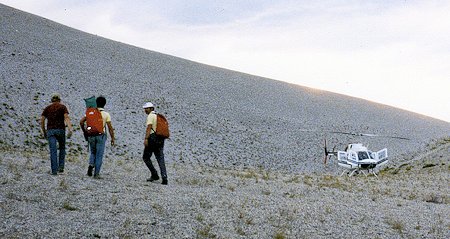
CHP Helicopter arrives on the scene at Mono Craters
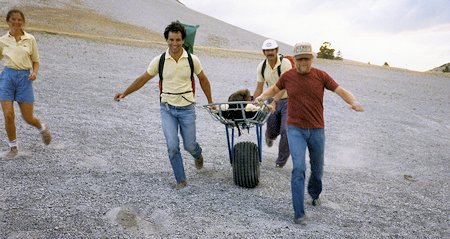
Moving injured party to CHP helicopter on wheeled litter
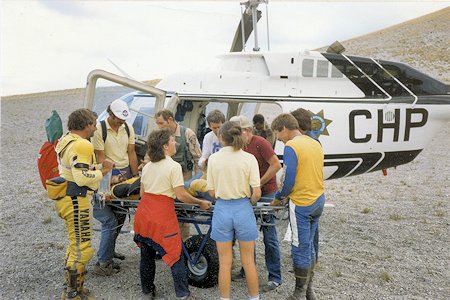
Preparing to load injured party into CHP helicopter
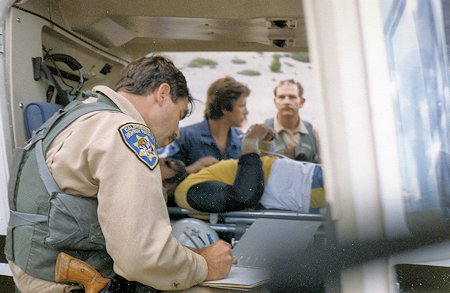
Injured party loaded in CHP helicopter - preparing to depart
August 14, 1984 Long Valley - Missing hiker - An Australian visitor was reported overdue from a hike west into the mountains from the Crowley Lake area. He was found before the van left the fire station. Responders were: Doug Nidever, Tennant, Verobyoff, Mammoth SAR Team
August 15, 1984 June Lake - Missing child - Shannon Lampson, a local 11-year old, was reported missing from home at around midnight. JLMRT and the fire department responded in very short time, about 20 minutes. A hasty search around the point last seen (Leonard Ave) led to her discovery in a closet inside the Community Center building in good condition. Responders were: Aldrich, Ellsworth, Gold, Doug and Sharon Nidever, Pete and Paula Schoerner, Tennant, Vorobyoff
From Mono Herald newspaper report by Rosanne Higley:
Motorcycle Accident, Missing Juvenile Keep Search Team On the Move It was a busy night for local search and rescue teams Tuesday. They were called out three times and all three ended successfully.
The June Lake and Mammoth Lakes Search and Rescue teams and the June Lake Paramedics responded to a dirt bike accident in the Mono Craters area at approximately 5 p.m.
James Sommer was riding a dirt bike south of Crater Mountain, the highest of the Mono Craters, when the bike fell over on him, according to the Mono County Sheriff's report.
Igov Vorobyoff of the June Lake Search and Rescue Team said that members of the rescue team hiked up the back of the Mono Craters with a litter. At the same time, paramedic Pete Levy rode a dirt bike up the mountain to the scene of the accident. Levy administered first aid until a CHP helicopter arrived.
The helicopter landed about 100 feet from the victim. Summer was transported to Southern Mono Hospital in Mammoth, with a fractured wrist and pain in his hips and chest, Vorobyoff said.
The second call-out occurred at 8:30 p.m. when John Hagar was reported overdue from a hike in the Castle Rock area, south of Mammoth. Thirty minutes later, that search was cancelled when Hagar was found by persons driving a four-wheel-drive vehicle and reunited with his party. Hagar had been "detained by the weather," according to the sheriff's report.
Just after midnight, the rescue teams were called again in response to a report of a missing juvenile in the June Lake area. The unnamed juvenile had been last seen at 7 p.m. with friends near Gull Lake. A search that included the June Lake Search and Rescue Team, with help from the June Lake Volunteer Fire Department, ended successfully when the juvenile was found about 1 a.m. near Gull Lake park, the sheriff's report concluded.
August 20, 1984 Waugh Lake - Injured backpacker - Melissa Robertson, 17 years old, injured her ankle at 1630 hrs on 19 August 1 mile cross-country north of Waugh lake. The June Lake team, LaBorde and the RP hiked to Waugh Dam, where they picked up a wheel-equipped litter belonging to Southern California Edison.
They met the SCE employees at the east end of Waugh Lake and then hiked to Melissa's campsite together, arriving at 1630 hrs. Melissa was then wheeled out to the west end of Gem Lake, accompanied by an adult supervisor and a young boy who needed medical attention for an eye injury.
The entire party was then transported, courtesy of SCE, by boat to Gem Dam, down the tramway to Agnew Lake, across the lake by barge, and then down to the power plant by tramway, arriving at 2130 hrs.
The wheeled litter worked well, but for long walkouts, six rescue members would be advisable. Responders were: Endo, Norton, Vorobyoff; Rick LaBorde (USFS), two SCE Employees
August 20, 1984 Ellery Lake - Injured hiker - Richard Horn, 23 years old, slid down a snow chute 70 feet on the south side of Ellery Lake while attempting to glissade, injuring his left leg by the knee. Ellsworth and Kauk hiked up to him, splinted his leg and lowered him 200 feet. A wheeled litter was then used to lower the subject the rest of the way. Responders were: Ellsworth, Norton, Paula Schoerner, Kauk (USFS), Mammoth SAR Team (5)
From Mono Herald newspaper report by Rosanne Higley:
"Skier Without Skis" Helps Keep Rescue Team Busy August continues to be a busy month, for the June Lake and Mammoth Lakes Search and Rescue teams who were called for two rescues on Monday, Aug. 20.
A teen-age girl with an injured right ankle was rescued from the backcountry near Waugh Lake above the June Lake Loop. At the same time, a young man with a broken leg was carried from an ice field near Ellery Lake on the Tioga Pass Road.
Melissa Robertson, 17, of the Athenian School, was hiking with a group of 16 teenagers and four adults when she was injured Sunday afternoon about 5 p.m.
Ken McClintock, search and rescue coordinator, said he received word of the injury at 9 a.m. Monday. The rescue team began the eight-mile hike to the girl's location about 10:30 a.m.
Southern California Edison, which maintains reservoirs at Gem, Agnew and Waugh lakes provided three additional rescuers and a wheeled litter. SCE also provided the rescue team with barge and boat rides across the reservoirs and with a ride down the mountain on their tramway, thus saving hours of hiking for rescuers.
The rescue at Ellery Lake began at 1:30 p.m. Monday, when a California highway patrolman was informed that Richard Horn, 23, of Atlanta, Ga., had broken his leg while glissading down a snow field.
Horn was just climbing and "fooling around," he said. He had been "skiing without skis" when his foot hit a rock and he "heard his leg break."
Rescuers climbed a steep mountainside of loose rock south of Ellery Lake to reach Horn. They said, however, that it was not a difficult climb; the rock was safe and the snow fields were soft enough to easily kick footholds.
The rescuers lowered Horn with ropes and rappelling techniques to an area where they could use a wheeled litter to transport him over the rocks to the road. The seven-hour rescue ended about dark.
Randy Robinson, president of the Mammoth Lakes Search and Rescue, praised the June Lake and Mammoth teams for "another smooth cooperative operation."
The June Lake Search and Rescue team historian commented that the number of rescues is beginning to catch up with last year. He said, "Last year we averaged a rescue every six days during the summer. This year we started out slowly, but we're catching up, fast. August has been a busy month."
A Mammoth Lakes paramedic spokesman also noted that "calls for his unit had been frequent this summer. "Often one call a day is about normal. Now we're getting numerous calls."
October
October 1, 1984 Warren Fork Canyon, Tioga Pass road - Wounded hunter - Bennett Roy Davison, 20 years old, was hiking up a trail at 0900 hrs when his hunting companion slipped and fell, causing his firearm to discharge. Bennett was hit to the right side of the spine at belt level; the exit wound was on the right side.
The rescue team was called out at 0930 hours and departed at 1000 hrs. When the van arrived at the Warren Fork curve at 1020 hrs, the Paramedics and Forest Service personnel (Ellsworth, Ellen Desmond (Huebner), third person unknown), were already with the victim.
Norton and Vorobyoff carried the wheeled litter up the first canyon to the east of Warren Fork one-third of a mile, where they were met by the victim being carried down on a Paramedic litter. The latter was place on the wheeled litter and strapped down. Then the victim was wheeled down to the highway by 1115 hrs in critical condition.
A Care-Flight helicopter took off for Carson City with the victim at 1145 hrs. Magee coordinated the effort from roadside, provided a communication like with Mono I, and assisted the helicopter to land.
This was McClintock's first walk-in since this historian has been on. We're all proud of him. Keep up the good work, Ken. Responders were: Ellsworth, Magee, Norton, Vorobyoff, USFS (2), McClintock
November
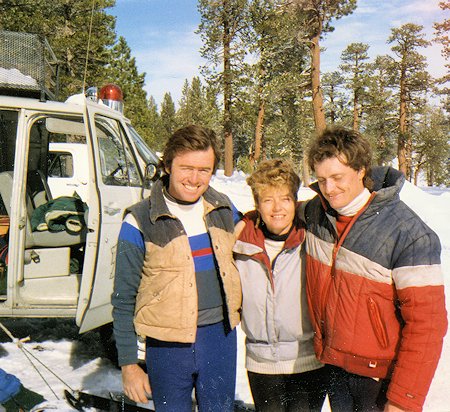
Jim Livingston, Jan Jaquette and Larry Welch at rescue van
November 22-23, 1984 June Mountain Ski Area - missing skiers - Whiteout conditions at the top of Chair 3 caused four skiers to stray over the back side of June Mountain.
One (Bill Wilson) was found by the ski patrol that evening. Jim Livingston, 22, strayed over the side alone at about 1000 hrs. He was joined an hour later by a couple (Jane Jaquette, 36 and Larry Welch, 35) who had not been reported missing.
At 2130 hrs Tennant and Vorobyoff skied up Glass Creek from the Crestview summer homes in search of tracks for about 1/2 mile, until dense timber and steep side slopes barred further progress.
Meanwhile two Mammoth SAR members skied up Glass Creek from its junction with the Obsidian Dome road. They were within 1/8 mile of the edge of Glass Creek Meadow when the operation was called off for the night (2330 hrs).
Neither party encountered tracks, though the Mammoth SAR party came to within 1/2 hour of tracks left by the subjects in the afternoon when they attempted unsuccessfully to ski out on their own.
Next morning Ellsworth and Vorobyoff took Chair 3 to the top to investigate tracks found in the previous evening by the ski patrol.
After following these tracks for 15 minutes, at 0815 Vorobyoff made visual and voice contact with three skiers in the meadow below. Fifteen minutes later Vorobyoff and Ellsworth met up with the subjects, who were cold and tired but in satisfactory condition.
After a snack of granola bars and an apple they were escorted down the drainage to its intersection with the Obsidian Dome road, where Aldrich met them with a snowmobile at 1130 hrs. Aldrich then ferried all individuals and equipment to the van waiting 1.5 miles down the road near the Obsidian Dome parking lot. Responders were: Aldrich, Ellsworth, Magee, Tennant, Vorobyoff, Mammoth SAR
From Mono Herald newspaper report by Rosanne Higley:
Four Skiers Rescued From Back of June Mountain - Three Spend Chilly Night Stranded Near Glass Creek Three men and one woman, who mistakenly skied off the back side of June Mountain in three separate misadventures Thanksgiving Day, were found in excellent condition despite foggy and cold weather.
Bill Wilson, 45, of San Diego, was rescued about 11 p.m. Thursday night. Jim Livingston, 22, of San Dimas, Jane Jaquette, 36, and Larry Welch, both of Fullerton, spent a cold night in Glass Creek Meadow before being found by the June Lake Search and Rescue Team Friday morning.
Wilson and Livingston were reported missing by their companions at the end of the day Thursday, according to June Mountain ski patrolman Steve Gold. "The ski patrol skied both edges of the mountain and checked the perimeters with snowmobiles and on skis," Gold said. "We had flashing lights going and we yelled a lot; but visibility was zero, improving to 50 yards about midnight."
Igor Vorobyoff of the June Mountain Search and Rescue Team said that both his team and the Mammoth Lakes Search and Rescue Team were asked to ski toward Glass Creek Meadow from U.S. 395 Thursday evening. "We skied up Glass Creek from the campground and the Mammoth team skied in Glass Flow Road," Vorobyoff said. "We went as far as possible, making a lot of noise." Their sounds were muffled by the light snow that fell during the search.
The missing skiers, meanwhile, behaved in "classic textbook fashion," according to Vorobyoff, doing all the right things to insure their own survival.
Wilson, skiing alone, explained that it took him a while to realize that he was not on a regular run. "I had probably gone about 350 yards down the mountain when I found little pine trees sticking out of the snow," he said. "Dusk was falling, increasing the visibility problem."
Wilson said he stopped and dug a pocket in the snow, where he was protected by the trees. "I was really scared. I rested for about an hour and a half. I felt better but was getting cold, so I started heading back up."
Wilson side stepped about 100 yards up the mountain, making slow progress in the two and a half to three-foot deep powder snow, he said. "I shouted a lot, but they couldn't hear me. Finally I began to hear the cats [grooming the slopes] above me. That was about 9:30 or 10 p.m." Wilson continued climbing the hill and shouting until the ski patrol finally heard him. "They made a trail, each one stepping in the others' tracks, and we climbed the hill."
"I was in good condition," Wilson said. "I could have lasted the night."
"They've got a great crew on June Mountain," he added. "I received great hospitality from them." Wilson rested Friday, but was back on the slopes Saturday.
Livingston, Jaquette and Welch's adventures lasted a bit longer, but followed a similar pattern, Vorobyoff said.
Livingston, skiing alone, went over the back side of June Mountain about 10 a.m. Thursday thinking he was on "Sunrise," an intermediate run, Vorobyoff said. "Jaquette and Welch, skiing together, did the same thing about 11 a.m."
"The two groups realized independently that they were in trouble," Vorobyoff said. "Jaquette and Welch saw Jim [Livingston], thought he was ski patrol, and hoped he would help them out. But Livingston was also lost. They banded together about 1 p.m. and tried side stepping up the mountain, but only went 20 yards in half an hour," Vorobyoff said.
"The three of them sat down to think out their situation, and agreed to try skiing through the meadow, following Glass Creek. When they reached the edge of the canyon, near Obsidian Dome, they turned back, because they didn't know where they were or what they would find down the cliff."
Vorobyoff said they returned up canyon and stopped to set up a camp about 4 p.m. They made a shelter with brush, created a little cubby-hole in the snow, and spent the night trading off the middle position.
"They were terrified by the whole thing," Vorobyoff said. "None of them had intentionally spent a night out before and they had no survival training. They didn't panic. They didn't walk blindly and get into more trouble." In the morning, they began making plans for their day, including skiing the word "HELP" in the middle of the meadow.
June Lake Search and Rescue, resuming their search from the top of Chair 3 Friday morning, made voice contact with the three victims about 8:15. "When we saw three people, we thought Livingston had met up with backpackers and had probably spent the night in a tent, warm and with food," Vorbyoff said. "We had no idea the other people were lost, too."
The searchers realized the situation when they made contact with the skiers about 15 minutes later. "We gave them our granola bars and apples, and began the three-hour ski-walk to Obsidian Dome. A snowmobile was waiting to take them to the rescue van," Vorobyoff said.
Livingston had to return home Saturday, Vorobyoff said. Jaquette and Welch apparently decided to cut their weekend short after their ordeal. "They had had enough," said Vorobyoff. "Jaquette and Welch will be getting married in two weeks. They told me this experience will probably strengthen their relationship."
December
No record of operations
December 19, 1984 - Training - Day ski tour, Glass Creek - Participants: John Ellsworth, Jim Endo, Steve Gold, Doug Nidever, Ted Norton, Pete Schoerner, Ron Tennant, Igor, Vorobyoff